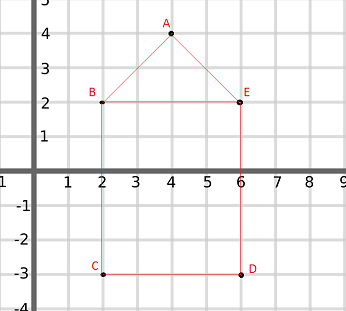Exams > Cat > Quantitaitve Aptitude
GEOMETRY SET I MCQs
Total Questions : 110
| Page 1 of 11 pages
Answer: Option A. -> 1
:
A
Option(a)
Slope of the line = y2−y1x2−x1=7−59−7=1
Here (x1,y1) = (7, 5) and(x2,y2) = (9, 7)
:
A
Option(a)
Slope of the line = y2−y1x2−x1=7−59−7=1
Here (x1,y1) = (7, 5) and(x2,y2) = (9, 7)
Answer: Option B. -> 2nd quadrant
:
B
2x + 2y + 1 = 0 …………….(i)
8x – 2y + 9 = 0 …………………………(ii)
After solving equation (i) and (ii)
x = - 1 and y = 12
(−1,12); which is in 2nd quadrant.
:
B
2x + 2y + 1 = 0 …………….(i)
8x – 2y + 9 = 0 …………………………(ii)
After solving equation (i) and (ii)
x = - 1 and y = 12
(−1,12); which is in 2nd quadrant.
Answer: Option D. -> 374√13
:
D
The given tangents are
2x+3y-9 = 0
4x+6y+19 =0
Or 2x + 3y + 192 = 0
Which are parallel, than distance between parallel tangents must be diameter of the circle than diameter.
∣∣∣192−(−9)∣∣∣√22+32=372√13
Radius = 12 diameter = 374√13
:
D
The given tangents are
2x+3y-9 = 0
4x+6y+19 =0
Or 2x + 3y + 192 = 0
Which are parallel, than distance between parallel tangents must be diameter of the circle than diameter.
∣∣∣192−(−9)∣∣∣√22+32=372√13
Radius = 12 diameter = 374√13
Answer: Option B. -> (172;−8)
:
B
Given, AB = 2BC
AB : BC = 2 : 1
Let C BE (h, k), then
(2h±12±1;2k±72±1) = (6, - 3) [B may divide AC internally or externally]
2h + 1 = 18 and 2k + 7 = - 9
(or) 2h - 1 = 6 , 2k - 7 = - 3
2h = 17 and 2k = - 16 (or) 2h = 7, 2k = 4
h = 172 and k = - 8 (or) h = 72; k = 2
C = (172;−8) or (172;2)
Option(b)
:
B
Given, AB = 2BC
AB : BC = 2 : 1
Let C BE (h, k), then
(2h±12±1;2k±72±1) = (6, - 3) [B may divide AC internally or externally]
2h + 1 = 18 and 2k + 7 = - 9
(or) 2h - 1 = 6 , 2k - 7 = - 3
2h = 17 and 2k = - 16 (or) 2h = 7, 2k = 4
h = 172 and k = - 8 (or) h = 72; k = 2
C = (172;−8) or (172;2)
Option(b)
Answer: Option D. -> -3√130
:
D
(d)sin α + sin β = -2165 , cosα + cos β = -2765
Now (sin α + sin β)2 + (cosα + cos β)2 = (−2165)2 +(−2765)2
⇒ 2 + 2 sin α sin β + 2 cos α cos β = 441652 + 729652
⇒ 2 + 2[cos (α - β)] = 1170(65)2 ⇒ 2.2 cos2(α+β2)=1170(65)2
⇒cos (α−β2) = 3√130130 = 3√130
Therefore cos (α−β2) = −3√130 , { ∵ π2 < α−β2 < 3π2 }
:
D
(d)sin α + sin β = -2165 , cosα + cos β = -2765
Now (sin α + sin β)2 + (cosα + cos β)2 = (−2165)2 +(−2765)2
⇒ 2 + 2 sin α sin β + 2 cos α cos β = 441652 + 729652
⇒ 2 + 2[cos (α - β)] = 1170(65)2 ⇒ 2.2 cos2(α+β2)=1170(65)2
⇒cos (α−β2) = 3√130130 = 3√130
Therefore cos (α−β2) = −3√130 , { ∵ π2 < α−β2 < 3π2 }
Answer: Option A. -> 12n/2
:
A
(a) Here (cot α1).(cot α2)....(cot αn)= 1
∴ cosα1.cosα2........cosαn = sinα1.sinα2........sinαn
Now, (cosα1.cosα2........cosαn)2
= (cosα1.cosα2........cosαn) (cosα1.cosα2........cosαn)
= (cosα1.cosα2........cosαn) (sinα1.sinα2........sinαn)
= 12n sin 2α1.sin 2α2........sin 2αn
But each of sin 2αi ≤ 1
(cosα1.cosα2........cosαn)2≤12n
But each of cos αi, is positive.
∴ cosα1.cosα2........cosαn ≤ √12n = 12n/2.
:
A
(a) Here (cot α1).(cot α2)....(cot αn)= 1
∴ cosα1.cosα2........cosαn = sinα1.sinα2........sinαn
Now, (cosα1.cosα2........cosαn)2
= (cosα1.cosα2........cosαn) (cosα1.cosα2........cosαn)
= (cosα1.cosα2........cosαn) (sinα1.sinα2........sinαn)
= 12n sin 2α1.sin 2α2........sin 2αn
But each of sin 2αi ≤ 1
(cosα1.cosα2........cosαn)2≤12n
But each of cos αi, is positive.
∴ cosα1.cosα2........cosαn ≤ √12n = 12n/2.
Answer: Option C. -> 2√1+k.
:
C
(c) Given α < β < γ < δ and sin α = sin β = sin γ = sin δ = k. Alsoα, β,γ,δ are smallest positive angles satisfying above two conditions.
∴ We can take β = π - α, γ = 2π + α, δ = 3π - α
Given expression
= 4 sin α2 + 3 sin(π2−α2) + 2 sin(π+α2) +3 sin(3π2−α2)
=4 sin α2 + 3cos α2 - 2sin α2 -cos α2 = 2 (sinα2+cosα2)
= 2 √(sin12α+cos12α)2 = 2 √1+sinα = 2√1+k.
:
C
(c) Given α < β < γ < δ and sin α = sin β = sin γ = sin δ = k. Alsoα, β,γ,δ are smallest positive angles satisfying above two conditions.
∴ We can take β = π - α, γ = 2π + α, δ = 3π - α
Given expression
= 4 sin α2 + 3 sin(π2−α2) + 2 sin(π+α2) +3 sin(3π2−α2)
=4 sin α2 + 3cos α2 - 2sin α2 -cos α2 = 2 (sinα2+cosα2)
= 2 √(sin12α+cos12α)2 = 2 √1+sinα = 2√1+k.
Answer: Option A. -> b2+(a−c)2
:
A
(a) asin2θ+bsinθcosθ+ccos2θ−12(a+c)
= 12[−acos2θ+bsin2θ+ccos2θ]
= 12[bsin2θ−(a−c)cos2θ]
∵|bsin2θ−(a−c)cos2θ|≤√b2+(a−c)2
∴∣∣∣12bsin2θ−(a−c)cos2θ∣∣∣≤12√b2+(a−c)2
∴K=√b2+(a−c)2
:
A
(a) asin2θ+bsinθcosθ+ccos2θ−12(a+c)
= 12[−acos2θ+bsin2θ+ccos2θ]
= 12[bsin2θ−(a−c)cos2θ]
∵|bsin2θ−(a−c)cos2θ|≤√b2+(a−c)2
∴∣∣∣12bsin2θ−(a−c)cos2θ∣∣∣≤12√b2+(a−c)2
∴K=√b2+(a−c)2


















